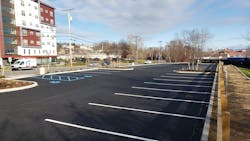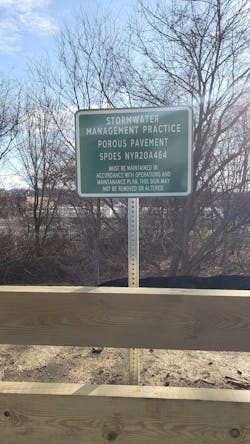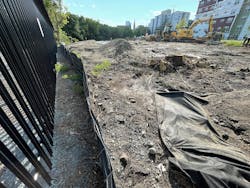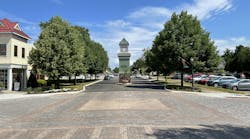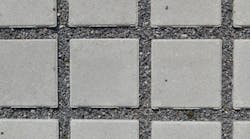After the Capital Repertory Theater near downtown Albany, New York, wrapped up a recent project to revitalize its facilities, they had a simple follow-on request of their engineers: “Let’s provide some overflow parking for our patrons.”
Normally that would be a pretty simple slam dunk. However, every “traditional” step they took as part of designing what was thought to be a simple parking lot presented additional constraints or twists.
One of the biggest surprises was that the parcel on which the theater wanted to put this parking lot was deemed an “archaeologically sensitive” site by the New York State Office of Parks, Recreation, and Historic Preservation (OPRHP). OPRHP issued a rather direct letter stating that the theater needed to look for a different site, otherwise they needed to be prepared for multiple expensive archaeological studies with no guarantee of receiving permission to disturb the site.
The “Henry Hudson” Rule
Locally referred to as the “Henry Hudson Rule,” it requires that the starting point for calculating “existing conditions” be what the area was like in 1609, when the English explorer Henry Hudson travelled up the river that now bears his name to what is now Albany. This is even though the theater is in a long-urbanized part of the city with pavement in every direction. This meant that the theater could not take advantage of redevelopment credits and needed to have the site modeled as unpaved and vegetated in the stormwater management plan.
The proposed impacted drainage area for the project was 0.71 acres, with a total proposed increase in impervious area of 0.34 acres. This put the project outside the threshold to meet New York State Department of Environmental Conservation (NYSDEC) stormwater standards, since the total disturbance would be less than an acre, meaning that the stormwater design had to meet the city’s stormwater requirements. To satisfy those requirements, the engineers not only needed to limit post-development runoff to, or below, the Henry Hudson Rule conditions, but also provide runoff reduction and meet water quality standards.
The soil at the site was typical for this part of the city – clay with overlying sandy, silty deposits. This presented an obstacle since the more permeable soils were located towards the surface layer. If soils were excavated to install an infiltration gallery to meet the city’s stormwater standards, the parking lot would be below the sandy permeable soils and into the restrictive clay layer.
During the design process, the engineers submitted the project for review by the Cultural Resource Information System (CRIS) to determine the location of archaeologically sensitive or historic areas near the site. The CRIS review stated that the site could not be disturbed below the surface, meaning that a new solution needed to be developed which resulted in zero disturbance of the site.
Picking the Pavement
After looking at many options, the client decided to go forward with a plan that included porous asphalt pavement for the parking lot that eliminated stormwater collection structures and trenching. The key restraint to the plan was the fact that zero site disturbance was allowed and required that the parking lot be built above the existing grade. The porous pavement allows rainwater to infiltrate into the pores of the asphalt and then filters the water through a series of layers of filter stone. This filter stone, below the porous pavement, has approximately 40% void space and allows the water to be attenuated beneath the pavement.
At the start of construction, the contractor cleared the vegetation on the site and placed a geotextile to “record the existing ground surface” in case there was a future archaeological study on the site. The geotextile fabric delineates the boundary between the existing surface and the parking lot above it. The parking lot had to “float” above the existing grade to preserve the natural soils beneath.
To further protect the existing soils, the city required that the filter stone beneath the pavement be wrapped in an impermeable liner. This would not allow rainwater to infiltrate into the surrounding soil and would therefore rely on the stone reservoir to accumulate and attenuate excess rainwater.
Next, a layered system of washed stone gradations, approved by the New York State Department of Transportation, created a porous stormwater reservoir and structural base for the porous asphalt surface. The volume of the stone voids below the parking lot surface exceeded what was needed to attenuate peak storm flows and the filter media of the porous pavement met the water quality volume (WQv) for the site. Stormwater captured within the stone is controlled with an outlet control structure that consists of a concrete weir wall and a 3-inch, low-level orifice. This allows water to build up within the stone layer of the porous pavement and slowly be released through the orifice. Water can also discharge above the top of the weir wall if the water level within the stone were to reach that height.
Another twist was that the Runoff Reduction Volume (RRV) could not be met for the site since infiltration was not permitted, per the city’s direction. Thus, a series of trees was planted around the parking lot to get a small amount of credit towards the total RRV. Per the city’s stormwater requirements, an informational sign was installed next to the parking lot that identified the porous pavement design and described its functionality. Standard borrow soils were imported and installed around the parking lot perimeter to provide a grassed transition to the rest of the site.
All ancillary parking lot items were also installed above the original grades. For example, the foundations for the parking lot light pole were designed to be shallow-spread footings. The pole supports solar powered lights with photovoltaic panels, with no trenching allowed to tie them to the grid. At the front of the site, topsoil was brought in to provide a planting berm for the required street trees and evergreen screening hedge.Addressing Maintenance
Of course, the client had questions about requirements for parking lot maintenance in this northern climate. It is important for the parking lot to be vacuumed at least once per year to ensure that the pores of the porous pavement remain unclogged for the system to work properly. They agreed to this requirement and to only use de-icing salt sparingly in the winter.
The parking lot construction was deemed substantially completed in the fall of 2022, with the lighting fixtures around the parking lot as the last remaining items to be installed.
Going forward, this new floating parking lot will not only provide overflow parking for the theater, but it will also add additional site security and lighting for the theater’s occupants within the limits of downtown Albany.
This approach to stormwater runoff management will provide important improvements to stormwater quality and quantity within the limits of a combined sewer overflow (CSO) area and illustrates a good example of how green infrastructure in a highly urbanized area can be implemented in other municipalities with similarly restrictive guidelines.
And finally, the success of Albany’s Capital Repertory Theater on this project provides an important investment in the community by adding additional access to a publicly used cultural resource.
